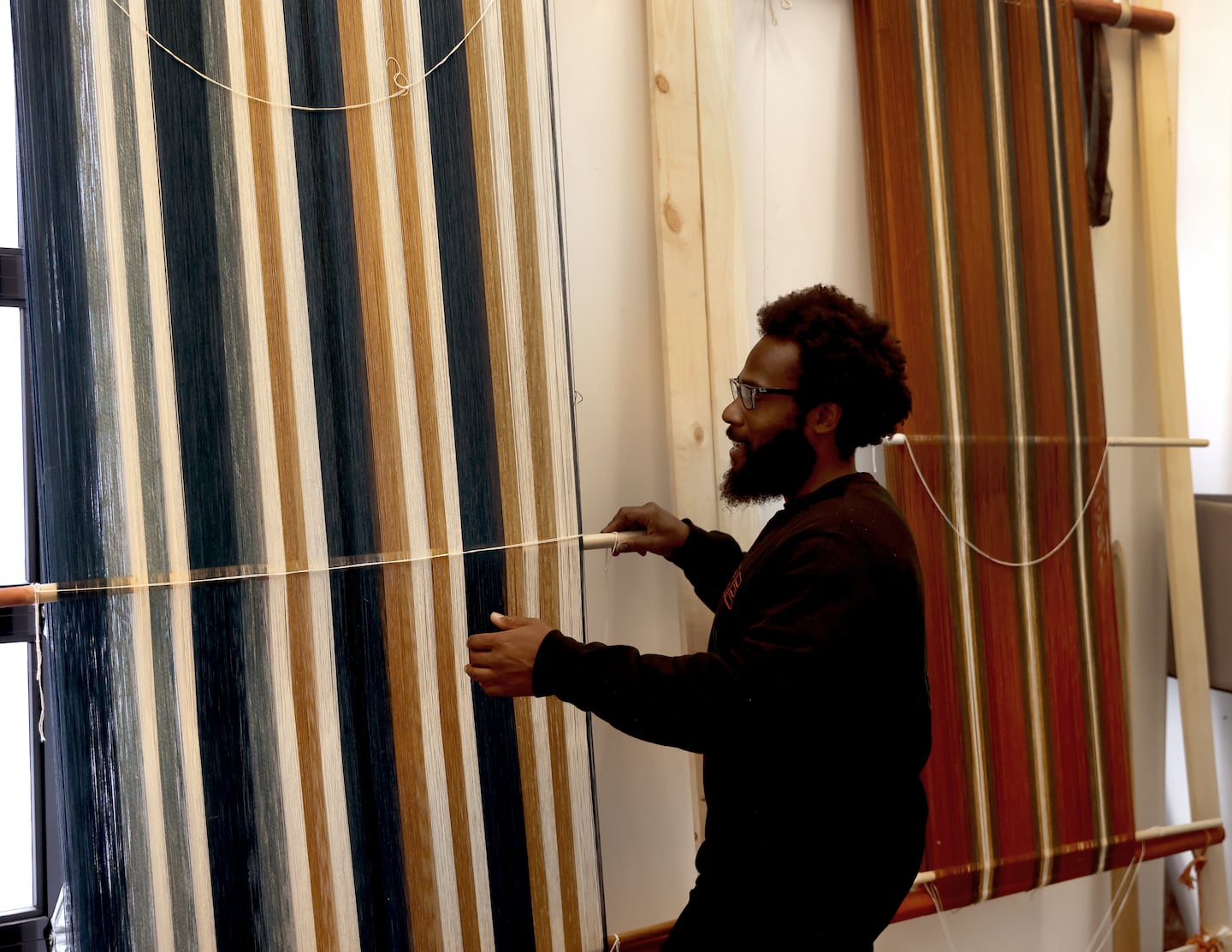Artist Stephen Hamilton invokes a Yoruba proverb when he talks about his work: “We greet the cloth before we greet the person.”
Hamilton’s 15-foot-tall painting on hand-woven fabric, mounted on a hand-carved upright loom, opens at Roxbury Community College on May 22 as part of the Boston Public Art Triennial.
“Cloth is something that carries memory. Cloth is something, as it touches the body, that absorbs all these residues of human existence,” the artist said. “Cloth represents transformation and development and growth, your passage through the life cycle.”
Earlier this month, Hamilton’s painting — titled “Under the Spider’s Web” — unfurled from the wall and over most of the floor of his Allston studio. It depicts African weavers: a man from Burkina Faso bends over his narrow strip of weaving; a Dida woman from the region of Ivory Coast or Liberia weaves a raffia textile without a loom. They’re all from West Africa and West Central Africa.
“They are regions people were taken from during the transatlantic slave trade,” Hamilton said. The traditions he portrays have dispersed all over the Globe.

“Under the Spider’s Web” is dense with texture, patterns, imagery, and handwork echoing generations of African traditions. Hamilton dyed yarns for the piece in natural pigments made from indigo, red sorghum, henna, and more. Ropes that hold everything together are hand-braided and dyed.
Hamilton, who is textiles for a PhD in African and African American Studies at Harvard , steeps every fiber of his art in research. He pointed to a woven passage on the right of the painted textile “That’s based off of the description from a Dutch trader in the Kingdom of Benin,” he said.
Triennial curator Tess Lukey first saw Hamilton’s work four years ago at the Museum of Fine Arts – the artist had work in the “New Light: Encounters and Connections” exhibition. “I was floored,” she said. “I knew this guy was going places.”
His combination of painting and textile art grabbed her, and he was one of the first area artists she thought of for the Triennial. “He’s pushing the limits of what both of those mediums are,” Lukey said.
Hamilton, 37, grew up in Roxbury surrounded by murals painted by Dana Chandler, Paul Goodnight, Gary Rickson, and other artists influenced by the Black Arts Movement. “There was a lot of public art that I grew up seeing,” he said, “and I was very inspired by that as a kid.”

He learned to weave during a nine-month trip to Nigeria in 2015 thanks to a grant from Arts Connect International. But he started out as an illustrator. “When you do that type of work, you’re very interested in material culture, thinking about how your characters dress, what type of weapons they use, what do their homes look like?” Hamilton said. ”I became really interested in African architecture, African weaponry, arms and armor. African textiles. How were they made? Where do they come from?”
It’s easy to think of “material culture” as just the things a society generates, but those things can carry mythic weight. The weavers in Hamilton’s painting wear deeply researched jewelry and clothing.
“There’s so much of that imagery that’s so rich and complex that people don’t have a visual reference to,” the artist said. “If you’re thinking about a Roman legionnaire, there’s these immediate visual references that you have. When it comes to Africa, a lot of people don’t have that visual reference.”

“I’m very interested in exposing people to that,” he added.
“He’s celebrating cloth in this incredible way that brings the past and the present together,” Lukey said.
If time collapses in Hamilton’s art, space expands. First, in the sheer proportion of his project — this is the largest piece he’s ever made. Then, in its warm embrace of the African diaspora.
“I’m thinking about the Black community as a global Black community,” Hamilton said. “What are these things that connect us?”
One answer, he said, is a shared heritage of jewelry, wood carving – and cloth.
“This idea of what cloth represents and clothing represents for Black people is something that is much deeper than simply a physical object, or simply representative of physical appearance,” he said.
“The roots of that go back long before our time in this country, long before the transatlantic slave trade,” Hamilton said. “There’s a deeper history there.”
Cate McQuaid can be reached at [email protected]. Follow her on Instagram @cate.mcquaid.
